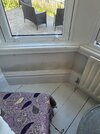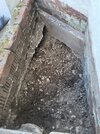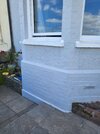Hi. We have lived in our semi-detached Victorian house for 4 years, but over the past months we have had an issue with what appears to be rising damp in the ground floor bay. We lifted a floorboard and everything is completely dry. We have repaired a hairline crack on the window ledge and have just dug up an outside flower bed which was directly next to the exterior wall, below the damp area in the Bay - but the floor level is several feet above the flower bed. My question is what is the best option for the hole - we removed a large bush that had very deep, thick roots and now need to fill the hole in - should we replace the original soil or would it be better to fill it with gravel? I've attached photos of the damp inside and the hole and would be extremely grateful for any advice for the hole and what to do with the damp in the bay (which doesn't feel wet, just very stained). Thank you.
Attachments
-
 WhatsApp Image 2024-06-09 at 14.41.35_44babcd9.jpg225 KB · Views: 49
WhatsApp Image 2024-06-09 at 14.41.35_44babcd9.jpg225 KB · Views: 49 -
 WhatsApp Image 2024-06-09 at 14.40.29_49c83add.jpg443.9 KB · Views: 45
WhatsApp Image 2024-06-09 at 14.40.29_49c83add.jpg443.9 KB · Views: 45 -
 WhatsApp Image 2024-06-09 at 14.40.26_8d040756.jpg335.2 KB · Views: 51
WhatsApp Image 2024-06-09 at 14.40.26_8d040756.jpg335.2 KB · Views: 51 -
 WhatsApp Image 2024-06-09 at 14.40.26_a8e7181a.jpg282.5 KB · Views: 51
WhatsApp Image 2024-06-09 at 14.40.26_a8e7181a.jpg282.5 KB · Views: 51 -
 WhatsApp Image 2024-06-09 at 14.40.26_c78d9e5b.jpg281.8 KB · Views: 50
WhatsApp Image 2024-06-09 at 14.40.26_c78d9e5b.jpg281.8 KB · Views: 50 -
 WhatsApp Image 2024-06-09 at 14.40.26_36b26101.jpg358.6 KB · Views: 53
WhatsApp Image 2024-06-09 at 14.40.26_36b26101.jpg358.6 KB · Views: 53

